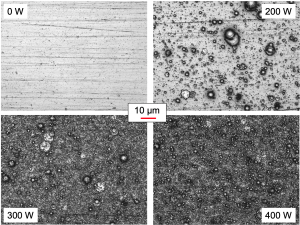Cody Moynihan
(With Steven Stemmley)
APOLLO:
Long-term use of lithium plasma-facing components (PFCs) cannot rely on the use of static liquid lithium. As lithium is a strong getter of fuel and impurity species, a stagnant surface will readily form an impurity layer which will diminish the benefits of the lithium surface. Therefore, a flowing system must be employed to keep the lithium surface free of impurities. The Actively Pumped Open-surface Lithium LOop (APOLLO) aims to demonstrate the technology for such a system on the lab scale.
APOLLO will consist of liquid lithium pumps, flowmeters, safety systems, and PFCs all with real-time response. Lithium is pumped from a reservoir into a vacuum system with an open-surface plate. This plate utilizes the Liquid Metal Infused Trench (LiMIT) concept to drive the liquid lithium flow using thermo-electric magnetohydrodynamics (TEMHD) when a heat flux is applied. APOLLO aims to demonstrate the technology readiness of liquid lithium components for use in larger scale devices.
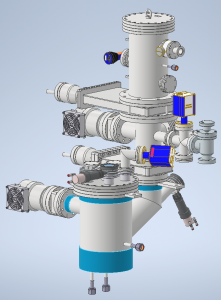
CoLLiNS:
High energy neutrons (~14.1 MeV) are of interest in both fusion and industrial applications. Typically, these neutrons are generated through beam-target fusion with the use of tritium. Unfortunately, tritium is radioactive and strictly controlled, making it quite expensive to handle. The Compact Liquid Lithium Neutron Source (CoLLiNS) device at the Center for Plasma-Material Interactions (CPMI) aims to examine the production of these high energy neutrons through the D-Li7 reaction. A compact, floating source ion beam accelerates the deuterium and focuses it on a self-contained, flowing liquid lithium target. The flow is self-driven via thermo-electric magnetohydrodynamics (TEMHD) through the use of permanent magnets and the heat flux from the ion beam. This experiment aims to investigate the neutron output and energy spectrum as well as the heat flux handling of this target.

HyDE:
Use of lithium as a plasma-facing component in fusion reactors has been shown to increase plasma performance. This is in part due to lithium’s ability to create a low-recycling regime inside the device. These low-recycling regimes are characterized by an absorbing wall that does not allow cold particles to escape back into the hot plasma. Lithium is able to getter any of the fusion fuel or impurity species that make it to the wall. However, the absorption of fusion fuel, specifically tritium poses some concerns for the long-term use of lithium in fusion devices.
At the Center for Plasma-Material Interactions, we are working to develop a variety of flowing lithium systems, along with hydrogen removal systems. The Hydrogen Desorption Experiment (HyDE) is working to develop a distillation column to use thermal desorption as a means to remove hydrogen species from the lithium bulk. This system has previously shown success at hydrogen removal in highly saturated lithium. Ongoing research is focusing on determining the efficiency of the device as a function of hydrogen saturation and developing specifications for its implementation into flowing system under reactor relevant conditions.

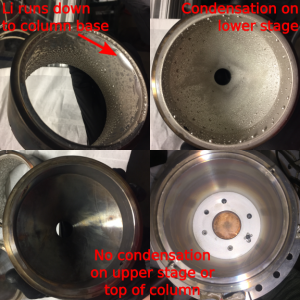
ICARUS:
Application of liquid lithium in devices is often limited by the incompatibility of lithium with required materials. One common example is copper, which has a wide array of uses in fusion devices. The Impulse Coatings for Application in Reactor Unprotected Surfaces (ICARUS) experiment at the Center for Plasma-Material Interactions, aims to develop metallic coatings for vulnerable surfaces to make them more robust against lithium exposure. This would allow for use of lithium in previously non-compatible environments. ICARUS allows for the rapid testing of a variety of coating recipes and coating materials. High-power Impulse Magnetron Sputtering (HiPIMS) is the leading method for developing dense, well adherent coatings on metallic substrates. ICARUS employs both HiPIMS as the coating technique (with the ability to control ion energy and sample temperature) and pre-treatment methods (plasma cleaning and etching) to develop advanced lithium-resistant coatings.


MALiCE:
A number of static lithium corrosion experiments have been performed over the last several decades. However, not many have been performed for extended periods of time at PFC relevant temperatures or utilizing modern analysis techniques. Materials Attacked by Lithium Corrosion Experiment (MALiCE) aims to perform extend (>2000 hr) static lithium corrosion tests at a temperature of 300C.A variety of materials are to be tested, including stainless steels, refractory metals, and incoloys, each possessing some use in fusion applications. Samples are characterized using a variety of optical and chemical techniques, including surface profilometry, ICP-OES, SIMS, FIB, and EDS.
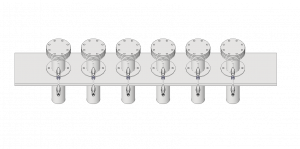
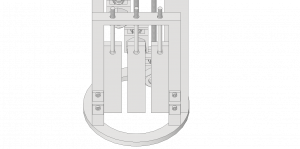
MCATS:
For proper functioning of lithium-based plasma-facing components (PFCs) control over the wettability of substrates must be known. The Materials Characterization and Analysis Test Stand (MCATS) chamber allows for rapid testing of lithium wetting on attractive materials over a large range of temperatures (200C – 750C). Material choice, surface roughness, and plasma treatment have all been shown to influence the lithium wettability. An understanding of these mechanisms and materials allows for the creation of components which can better control the flow of liquid lithium. For example, the nano-texturing of portions of a polished stainless steel plate may allow us to guide lithium flow on a flat plate with no need for physical walls. These techniques and experiences can be used to guide the fabrication of many lithium-based devices (PFCs, lithium injectors, lithium pumps, etc.).
Current work in MCATS is centered around ensuring that particular materials do no wet with lithium, such that if lithium is splashed on that surface, it will readily leave the surface. These tests are looking into many materials (metals, ceramics, polymers) that have application in fusion devices. Varying surface roughness and plasma treatment is being investigated to ensure that as a plasma cleans the surface or sputtering smooths the surface, a transition to wetting will not occur.


SLAPS:
In order to be able to fully utilize liquid metals in fusion devices, their corrosive attack on a variety of materials needs to be known. Particularly, lithium attack on the structural components of a device are of concern.
Previous work has looked at static lithium corrosion, often under extreme temperatures. The Spinning Lithium Attacking Potential Substrates (SLAPS) device at the Center for Plasma-Material Interactions investigates the effect of rotating lithium at relevant temperatures on the corrosion behavior of potential materials. SLAPS consists of a spindle with a variety of mounted samples which rotate in a bucket of molten lithium at operating temperatures (~300C) for multiple days (~100 hrs).Rotation allows the investigation of fluid shear on the corrosion dynamics. Mechanical properties of the materials are of prime concern for this project, so each material undergoes tensile testing before and after lithium exposure to determine how lithium has changed material performance. Additionally, 3D optical profilometry is employed to determine if microscopic surface changes have occurred. SLAPS will allow us to provide candidate materials for use in a variety of components in fusion devices.
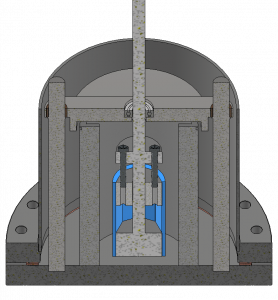
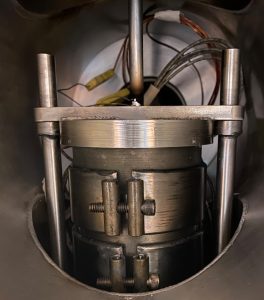
SLiDE:
The Solid/Liquid Divertor Experiment (SLiDE) is a high vacuum experiment aimed to test a variety of divertor concepts developed at the Center for Plasma Material Interactions. An electron beam is used to replicate the heat flux produced in the divertor region of fusion devices. Beam shape and peak intensity can be controlled be changing the magnetic field in the device. SLiDE has tested a variety of divertor concepts and most recently has been used for testing the Liquid Metal Infused Trenches (LiMIT) technology. LiMIT utilizes thermo-electric magnetohydrodynamics to drive the flow when a heat flux (thermal gradient) is applied to the surface. This technology aims to provide a constant, clean liquid lithium surface to the fusion divertor which can handle the massive heat flux in fusion devices and consistently provide the plasma performance benefits of lithium. Recently, work has been done to test the heat flux handling of a variety of different tile geometries, including 3D printed trench designs. In the near future, SLiDE will be incorporated in the Actively Pumped Open-surface Lithium Loop (APOLLO) to demonstrate LiMIT’s ability to be used in a full flowing loop system.

TUFCON:
The TUnsten Fuzz Characterization by heliCON (TUFCON) chamber was originally used to investigate the formation of tungsten fuzz after helium plasma exposure. This work performed parametric sweeps over ion energy and fluence to determine the causes of the fuzz formation. Recently, the device has been used to determine the effect of hydrogen plasma parameters and radical density on the spitting of microdroplets from liquid metals (tin, lithium, tin-lithium).Upon radical or plasma exposure, hydrogen bubbles form in the molten metal, which eventually migrate to the surface and burst, releasing microdroplets of liquid metals. This could be extremely detrimental to fusion plasma operation, as droplets entering the core plasma would reduce the plasma performance. In an effort to better understand these droplets, the plasma in TUFCON is being fully characterized by Langmuir probe and radical probe to determine plasma temperature, plasma density, and radical density. After the plasma is fully characterized, a microdroplet size distribution will be made as a function of liquid temperature and plasma parameters. Eventually, the aim is to implement techniques which can mitigate the droplet emission or prevent the droplets from entering the core plasma.

